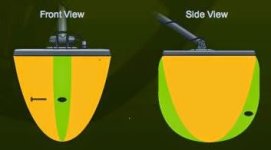I am not sure if I can be much help here Kev.
Therefore I will just muddle things up as ususal.
Since you did bring up variables and how they affect choices of coil.
Let's put a wine screw cap 3 inches under the center of the coil .
Now how much of your volume is left ?
Even a rivet at a couple inches or a small nail must cast a shadow down into the volume below it. Is the volume the same if you are running with no discrimination ? Yet when you disc out the nail are you losing everything in that shadow so to speak as if we were shining a light down from above.
A form of what we call (masking ) but in my opinion masking is more of an item you have discriminated out actually shutting your machines down for a fraction of a second that creates a blind spot during your swing directly behind the target. If you run a threashold back ground hum these notched window closings can become more evident.
That is one thing I always wondered about the CTX and its abuility to show two separate targets on the veiw screan .
Have you ever run that mode and have you ever seen two targets say an iron nail and a coin one directly below the other ?
Or is it only more side by side with variations in depth?
Can that rig capture all of the volume or is there still a shadow that hides things below.
I'm guessing yes there is a shadow .
Let's not forget frequency .. as machines calibrated for silver can sift threw let's say a gallon of volume with a certain coil.
But hunt gold without a frequency more suitable for gold nuggets is your same coil only capable to sort thre a half gallon of volume on the lower conductor?
I am not sure what the actual question is here .
Are you adding a small coil? Then get one for the job. No cross over volume advantage. Scout with your stock coil . You know what to do with your 17 already. Go for the sniper . A surgical instrument. Overlap is unnecessary.
In theory a smaller coil is capable of less depth but in trash more capable of casting less shadows as there are less items under the coil at a given time .
Sort of like using a weed eater around the tree (trash ) rather then a 52 inch rider . Or Like digging under a root for a target .. a smaller coil can come in closer and even be more likely to come in underneath the problem at An angle with the twist of the wrist.
I think this is where these new machines and technologies are offering up some major advantages running multiple frequencies and angles from the coils .
They are capable of giving us a better chance to hear a chirp or clue that we should stop and investigate.
From there it's up to us to analyze the mess of what combinations are under that coil.
I would say the more volume the better if the information gathered an paint a good picture.
We hunt in a cherry pickers mindset. Some trashy spots the smaller coil is better.
Less volume means less garble.
If we would have a dig it all mentality all of the garble would get removed from the ground until we gave it a final full volume sweep and nothing was left.
I have dug plenty of silver at around 6 inches in a pile of trash that has given me a low penny zink or Indian signal . These are extremely messy spots .
How to know how much volume is being seen under my coil at that time is hard to guess.
But at that time my Etrac is hitting on a coin and average conductivity is braught down from a solid 12-46 to a ? - 35 due to all the !!!! under the coil.
Maybe the smaller coil and smaller window would have braught down that number by only a few. Who knows .
We do know it's likely to be a coin and in old very messy dirt that's been over a hundread times and the fact that based on experience and the fact that I can hear the other low conductors around it I have high percentage target down there.
Finding the fish and then fine tuning your equipment and methods is the key.
If your asking this question because your considering adding a sniper or small coil . I would say go for it . The stock coil is in my opinion the best starting point until you know it's time to go deeper . Yet trash pockets after a short investigation of potential would have me running to the truck for that small coil pretty quickly. Less volume can be amazing.
Having all three coils on my Vaquero taught me that the smaller viewing window is very fun and worth wile . That 5 inch is amazing in a garage pile.
Sorry to garble up your thread Kev.
You are a master technician Kev .
You have multiple sizes of the same tool in the box for a reason. Things that allow you to get at things from all angles . but we all know Your mind is the sharpest tool in the box.

,Dew






 Well...right now you have FROZEN mud! I have a few places I can still get through but these are closer by and have been tilled thoroughly...hence my desire to put on the tiny coil and root around.
Well...right now you have FROZEN mud! I have a few places I can still get through but these are closer by and have been tilled thoroughly...hence my desire to put on the tiny coil and root around.

